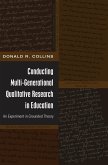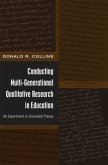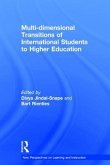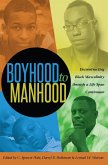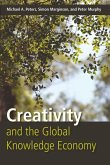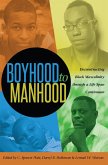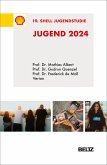The Palgrave International Handbook of Multiple and Multi-Dimensional Educational and Life Transitions
Herausgeber: Jindal-Snape, Divya
Versandkostenfrei innerhalb Deutschlands
191,99 €
inkl. MwSt.
Versandkostenfrei*
Erscheint vorauss. 1. Juni 2026
Melden Sie sich
hier
hier
für den Produktalarm an, um über die Verfügbarkeit des Produkts informiert zu werden.

96 °P sammeln
The Palgrave International Handbook of Multiple and Multi-Dimensional Educational and Life Transitions
Herausgeber: Jindal-Snape, Divya
- Gebundenes Buch
This is an international, interdisciplinary and research-based handbook about various educational and life transitions. This handbook has 30 chapters, divided into five parts according to the focus of the chapters on: theoretical/conceptual, multiple transitions, multi-dimensional transitions, dynamic environment, and research/practice/education. Editor Jindal-Snape's Multiple and Multi-dimensional Transitions (MMT) Theory runs as a thread through and between each chapter. MMT Theory takes a complex view of transitions and proposes that each individual experiences multiple transitions…mehr
Andere Kunden interessierten sich auch für
![Conducting Multi-Generational Qualitative Research in Education Conducting Multi-Generational Qualitative Research in Education]() Donald R. CollinsConducting Multi-Generational Qualitative Research in Education39,15 €
Donald R. CollinsConducting Multi-Generational Qualitative Research in Education39,15 €![Conducting Multi-Generational Qualitative Research in Education Conducting Multi-Generational Qualitative Research in Education]() Donald R. CollinsConducting Multi-Generational Qualitative Research in Education137,35 €
Donald R. CollinsConducting Multi-Generational Qualitative Research in Education137,35 €![Multi-dimensional Transitions of International Students to Higher Education Multi-dimensional Transitions of International Students to Higher Education]() Multi-dimensional Transitions of International Students to Higher Education195,99 €
Multi-dimensional Transitions of International Students to Higher Education195,99 €![Boyhood to Manhood Boyhood to Manhood]() Boyhood to Manhood155,70 €
Boyhood to Manhood155,70 €![Creativity and the Global Knowledge Economy Creativity and the Global Knowledge Economy]() Michael Adrian PetersCreativity and the Global Knowledge Economy40,50 €
Michael Adrian PetersCreativity and the Global Knowledge Economy40,50 €![Boyhood to Manhood Boyhood to Manhood]() Boyhood to Manhood41,85 €
Boyhood to Manhood41,85 €![Jugend 2024 - 19. Shell Jugendstudie Jugend 2024 - 19. Shell Jugendstudie]() Mathias AlbertJugend 2024 - 19. Shell Jugendstudie26,00 €
Mathias AlbertJugend 2024 - 19. Shell Jugendstudie26,00 €-
-
-
This is an international, interdisciplinary and research-based handbook about various educational and life transitions. This handbook has 30 chapters, divided into five parts according to the focus of the chapters on: theoretical/conceptual, multiple transitions, multi-dimensional transitions, dynamic environment, and research/practice/education. Editor Jindal-Snape's Multiple and Multi-dimensional Transitions (MMT) Theory runs as a thread through and between each chapter. MMT Theory takes a complex view of transitions and proposes that each individual experiences multiple transitions simultaneously, and in doing so can trigger transitions for significant others, and vice versa. Chapters lean into this complexity as they delve into childhood and youth transitions into education and care and between school and work, as well as professional transitions into leadership, and family and life transitions. The handbook is the first reference work to establish transitions research as a field in its own right. It presents two new frameworks and principles for undertaking effective multiple and multi-dimensional transitions research and practice. This handbook will be of relevance to researchers and professionals, from a range of sectors, disciplines and regions. The engaging style of the chapters, make complex concepts accessible to those with varied levels of expertise in transitions research and practice.
Produktdetails
- Produktdetails
- Verlag: Springer International Publishing AG / Springer-Verlag GmbH
- Artikelnr. des Verlages: 89275582
- Erscheinungstermin: 1. Juni 2026
- Englisch
- ISBN-13: 9783032111449
- ISBN-10: 3032111447
- Artikelnr.: 75618857
- Herstellerkennzeichnung
- Springer-Verlag GmbH
- Tiergartenstr. 17
- 69121 Heidelberg
- ProductSafety@springernature.com
- Verlag: Springer International Publishing AG / Springer-Verlag GmbH
- Artikelnr. des Verlages: 89275582
- Erscheinungstermin: 1. Juni 2026
- Englisch
- ISBN-13: 9783032111449
- ISBN-10: 3032111447
- Artikelnr.: 75618857
- Herstellerkennzeichnung
- Springer-Verlag GmbH
- Tiergartenstr. 17
- 69121 Heidelberg
- ProductSafety@springernature.com
Professor Divya Jindal-Snape is Personal Chair of Education, Inclusion, and Life Transitions within the Division of Education and Society in the School of Humanities, Social Sciences, and Law at the University of Dundee, Scotland. She is Director of the Transformative Change: Educational and Life Transitions (TCELT) Research Centre and leads on the International Network of Transitions Researchers (TCELT-INTR). She was also the Editor-in-Chief of The International Journal of Educational and Life Transitions from its conception to December 2024.
Part 1: Conceptualization and Theorization of Transitions.
1. Understanding Multiple and Multi
dimensional Transitions Theory and XII Pillars.
2. Temporal Transitions In and Out of Change: An Example of International Students.
3. Exploring the Potential of Multiple and Multi
Dimensional Transitions Theory to Reconceptualize Intercultural Relationships in Higher Education Institutions and Beyond.
4. Everything is Moving, So How Do I Start and Where Should I Stop? Concepts of Transition in Social Work Practice and Social Work Education.
5. Experiencing Liminality During Healthcare Professionals' Multiple, Multi
Dimensional Transitions.
Part 2: Multiple Transitions with a Focus on Education, Professional, and Life Transitions.
6. 'Be Your Own Shephard, Don't Be a Sheep': The Development of Reader Identities Over the Primary
Secondary School Transition in England.
7. Exploring the Transition from Primary to Secondary School in Wales.
8. Transitions to Secondary School in Spain.
9. School Transitions, School Mobility, and Transfers Between Different School Settings in Special Education in Switzerland.
10. Supporting Transitions for Care
Experienced Young People: Exploring the Importance of Social Capital in their Education and Life Transitions.
11. Multiple and Multi
Dimensional Life Transitions of Care Leavers in Latvia.
12. Students' Multiple Transitions During Tertiary Education and the Resilience Competencies.
13. The Being and Becoming: Exploring the Identity & Transition Experiences of Pakistani Students Who Return Home After Studying in the UK.
14. Critiquing and Developing Transitions Theory in Health Education: Exploring New Graduates' Transitions to Practice.
15. Transitioning in and Transitioning Out: A Comparison of International Scholars' Learning Engagement in the Early and Post
COVID
19 Phases.
16. Transition of New Dental Graduates from University Life to Professional Dental Practice.
17. Transitions of Queer Teachers Moving into Leadership Roles.
18. Supporting their School Communities During and in the Aftermath of Lockdown: Changing Perceptions of Former Into Headship Students of their Role and Its Perceived Impact in the Community.
Part 3: Multi
Dimensional Transitions of Significant Others with a Focus on Families and Peers.
19. First Transitions to Early Childhood Education and Care Settings: The Experience of International Families in the UAE.
20. Transitions of Armed Forces Families.
21. Life Transitions of International Families within the Context of an International School.
22. Life Transitions of Families of Children Living with Rare Diseases.
23. Navigating Workplace Transitions: Perspectives on Older Workers Identified with Mild Cognitive Impairment and Dementia on the Job.
24. When Home Becomes a Workplace: Using Multiple and Multi
Dimensional Transitions Theory to Map Transitions of Co
Habiting Carers of a Person Living with Dementia in Scotland.
25. Care Transitions from Hospital to Home in Middle East/North Africa (MENA): The Experiences of Older People, Their Families, and Healthcare Professionals.
26. Transitions of Women Approaching Menopause who are Parenting Daughters Approaching Menarche.
27. Multiple and Multi
Dimensional Life Transitions of World Transplant Athletes.
Part 4: Multiple and Multi
Dimensional Transitions Research, Interventions, and Practice.
28. Undertaking Research Informed by MMT Theory: The Case for Longitudinal and Multiple Perspectives Research.
29. Young Children as Active Participants in their Transitions to School.
30. Disabled People as Co
Researchers of their Multiple and Multi
Dimensional Life Transitions.
31. Using Social Network Analysis to Understand Complex, Multiple and Multi
Dimensional Transitions.
32. Photovoice and MMT: Considering Multiple Perspectives in Participatory Action Research.
33. Using Longitudinal Audio
Diaries as a Method to Research MMT.
34. Narrative Analysis Research and MMT Theory.
35. Measuring Emotional Wellbeing Outcomes within Transitions Research.
36. Mapping the Multi
Dimensional Transition to Higher Education Assessing Academic and Social Integration with the First
Year Integration Test (FIT).
37. Primary
Secondary School Transitions Interventions: A Multiple and Multi
Dimensional Transitions Theory Perspective.
38. Using Longitudinal MMT Data to Develop Interventions to Support Wellbeing.
39. The Co
Production of School Transitions Guidance for Children with Autistic Spectrum Disorder (ASD): Applying Multiple and Multi
Dimensional Transition Theory (MMT) to Practice.
40. Lessons Learned: Where Next with MMT Theory?.
1. Understanding Multiple and Multi
dimensional Transitions Theory and XII Pillars.
2. Temporal Transitions In and Out of Change: An Example of International Students.
3. Exploring the Potential of Multiple and Multi
Dimensional Transitions Theory to Reconceptualize Intercultural Relationships in Higher Education Institutions and Beyond.
4. Everything is Moving, So How Do I Start and Where Should I Stop? Concepts of Transition in Social Work Practice and Social Work Education.
5. Experiencing Liminality During Healthcare Professionals' Multiple, Multi
Dimensional Transitions.
Part 2: Multiple Transitions with a Focus on Education, Professional, and Life Transitions.
6. 'Be Your Own Shephard, Don't Be a Sheep': The Development of Reader Identities Over the Primary
Secondary School Transition in England.
7. Exploring the Transition from Primary to Secondary School in Wales.
8. Transitions to Secondary School in Spain.
9. School Transitions, School Mobility, and Transfers Between Different School Settings in Special Education in Switzerland.
10. Supporting Transitions for Care
Experienced Young People: Exploring the Importance of Social Capital in their Education and Life Transitions.
11. Multiple and Multi
Dimensional Life Transitions of Care Leavers in Latvia.
12. Students' Multiple Transitions During Tertiary Education and the Resilience Competencies.
13. The Being and Becoming: Exploring the Identity & Transition Experiences of Pakistani Students Who Return Home After Studying in the UK.
14. Critiquing and Developing Transitions Theory in Health Education: Exploring New Graduates' Transitions to Practice.
15. Transitioning in and Transitioning Out: A Comparison of International Scholars' Learning Engagement in the Early and Post
COVID
19 Phases.
16. Transition of New Dental Graduates from University Life to Professional Dental Practice.
17. Transitions of Queer Teachers Moving into Leadership Roles.
18. Supporting their School Communities During and in the Aftermath of Lockdown: Changing Perceptions of Former Into Headship Students of their Role and Its Perceived Impact in the Community.
Part 3: Multi
Dimensional Transitions of Significant Others with a Focus on Families and Peers.
19. First Transitions to Early Childhood Education and Care Settings: The Experience of International Families in the UAE.
20. Transitions of Armed Forces Families.
21. Life Transitions of International Families within the Context of an International School.
22. Life Transitions of Families of Children Living with Rare Diseases.
23. Navigating Workplace Transitions: Perspectives on Older Workers Identified with Mild Cognitive Impairment and Dementia on the Job.
24. When Home Becomes a Workplace: Using Multiple and Multi
Dimensional Transitions Theory to Map Transitions of Co
Habiting Carers of a Person Living with Dementia in Scotland.
25. Care Transitions from Hospital to Home in Middle East/North Africa (MENA): The Experiences of Older People, Their Families, and Healthcare Professionals.
26. Transitions of Women Approaching Menopause who are Parenting Daughters Approaching Menarche.
27. Multiple and Multi
Dimensional Life Transitions of World Transplant Athletes.
Part 4: Multiple and Multi
Dimensional Transitions Research, Interventions, and Practice.
28. Undertaking Research Informed by MMT Theory: The Case for Longitudinal and Multiple Perspectives Research.
29. Young Children as Active Participants in their Transitions to School.
30. Disabled People as Co
Researchers of their Multiple and Multi
Dimensional Life Transitions.
31. Using Social Network Analysis to Understand Complex, Multiple and Multi
Dimensional Transitions.
32. Photovoice and MMT: Considering Multiple Perspectives in Participatory Action Research.
33. Using Longitudinal Audio
Diaries as a Method to Research MMT.
34. Narrative Analysis Research and MMT Theory.
35. Measuring Emotional Wellbeing Outcomes within Transitions Research.
36. Mapping the Multi
Dimensional Transition to Higher Education Assessing Academic and Social Integration with the First
Year Integration Test (FIT).
37. Primary
Secondary School Transitions Interventions: A Multiple and Multi
Dimensional Transitions Theory Perspective.
38. Using Longitudinal MMT Data to Develop Interventions to Support Wellbeing.
39. The Co
Production of School Transitions Guidance for Children with Autistic Spectrum Disorder (ASD): Applying Multiple and Multi
Dimensional Transition Theory (MMT) to Practice.
40. Lessons Learned: Where Next with MMT Theory?.
Part 1: Conceptualization and Theorization of Transitions.
1. Understanding Multiple and Multi
dimensional Transitions Theory and XII Pillars.
2. Temporal Transitions In and Out of Change: An Example of International Students.
3. Exploring the Potential of Multiple and Multi
Dimensional Transitions Theory to Reconceptualize Intercultural Relationships in Higher Education Institutions and Beyond.
4. Everything is Moving, So How Do I Start and Where Should I Stop? Concepts of Transition in Social Work Practice and Social Work Education.
5. Experiencing Liminality During Healthcare Professionals' Multiple, Multi
Dimensional Transitions.
Part 2: Multiple Transitions with a Focus on Education, Professional, and Life Transitions.
6. 'Be Your Own Shephard, Don't Be a Sheep': The Development of Reader Identities Over the Primary
Secondary School Transition in England.
7. Exploring the Transition from Primary to Secondary School in Wales.
8. Transitions to Secondary School in Spain.
9. School Transitions, School Mobility, and Transfers Between Different School Settings in Special Education in Switzerland.
10. Supporting Transitions for Care
Experienced Young People: Exploring the Importance of Social Capital in their Education and Life Transitions.
11. Multiple and Multi
Dimensional Life Transitions of Care Leavers in Latvia.
12. Students' Multiple Transitions During Tertiary Education and the Resilience Competencies.
13. The Being and Becoming: Exploring the Identity & Transition Experiences of Pakistani Students Who Return Home After Studying in the UK.
14. Critiquing and Developing Transitions Theory in Health Education: Exploring New Graduates' Transitions to Practice.
15. Transitioning in and Transitioning Out: A Comparison of International Scholars' Learning Engagement in the Early and Post
COVID
19 Phases.
16. Transition of New Dental Graduates from University Life to Professional Dental Practice.
17. Transitions of Queer Teachers Moving into Leadership Roles.
18. Supporting their School Communities During and in the Aftermath of Lockdown: Changing Perceptions of Former Into Headship Students of their Role and Its Perceived Impact in the Community.
Part 3: Multi
Dimensional Transitions of Significant Others with a Focus on Families and Peers.
19. First Transitions to Early Childhood Education and Care Settings: The Experience of International Families in the UAE.
20. Transitions of Armed Forces Families.
21. Life Transitions of International Families within the Context of an International School.
22. Life Transitions of Families of Children Living with Rare Diseases.
23. Navigating Workplace Transitions: Perspectives on Older Workers Identified with Mild Cognitive Impairment and Dementia on the Job.
24. When Home Becomes a Workplace: Using Multiple and Multi
Dimensional Transitions Theory to Map Transitions of Co
Habiting Carers of a Person Living with Dementia in Scotland.
25. Care Transitions from Hospital to Home in Middle East/North Africa (MENA): The Experiences of Older People, Their Families, and Healthcare Professionals.
26. Transitions of Women Approaching Menopause who are Parenting Daughters Approaching Menarche.
27. Multiple and Multi
Dimensional Life Transitions of World Transplant Athletes.
Part 4: Multiple and Multi
Dimensional Transitions Research, Interventions, and Practice.
28. Undertaking Research Informed by MMT Theory: The Case for Longitudinal and Multiple Perspectives Research.
29. Young Children as Active Participants in their Transitions to School.
30. Disabled People as Co
Researchers of their Multiple and Multi
Dimensional Life Transitions.
31. Using Social Network Analysis to Understand Complex, Multiple and Multi
Dimensional Transitions.
32. Photovoice and MMT: Considering Multiple Perspectives in Participatory Action Research.
33. Using Longitudinal Audio
Diaries as a Method to Research MMT.
34. Narrative Analysis Research and MMT Theory.
35. Measuring Emotional Wellbeing Outcomes within Transitions Research.
36. Mapping the Multi
Dimensional Transition to Higher Education Assessing Academic and Social Integration with the First
Year Integration Test (FIT).
37. Primary
Secondary School Transitions Interventions: A Multiple and Multi
Dimensional Transitions Theory Perspective.
38. Using Longitudinal MMT Data to Develop Interventions to Support Wellbeing.
39. The Co
Production of School Transitions Guidance for Children with Autistic Spectrum Disorder (ASD): Applying Multiple and Multi
Dimensional Transition Theory (MMT) to Practice.
40. Lessons Learned: Where Next with MMT Theory?.
1. Understanding Multiple and Multi
dimensional Transitions Theory and XII Pillars.
2. Temporal Transitions In and Out of Change: An Example of International Students.
3. Exploring the Potential of Multiple and Multi
Dimensional Transitions Theory to Reconceptualize Intercultural Relationships in Higher Education Institutions and Beyond.
4. Everything is Moving, So How Do I Start and Where Should I Stop? Concepts of Transition in Social Work Practice and Social Work Education.
5. Experiencing Liminality During Healthcare Professionals' Multiple, Multi
Dimensional Transitions.
Part 2: Multiple Transitions with a Focus on Education, Professional, and Life Transitions.
6. 'Be Your Own Shephard, Don't Be a Sheep': The Development of Reader Identities Over the Primary
Secondary School Transition in England.
7. Exploring the Transition from Primary to Secondary School in Wales.
8. Transitions to Secondary School in Spain.
9. School Transitions, School Mobility, and Transfers Between Different School Settings in Special Education in Switzerland.
10. Supporting Transitions for Care
Experienced Young People: Exploring the Importance of Social Capital in their Education and Life Transitions.
11. Multiple and Multi
Dimensional Life Transitions of Care Leavers in Latvia.
12. Students' Multiple Transitions During Tertiary Education and the Resilience Competencies.
13. The Being and Becoming: Exploring the Identity & Transition Experiences of Pakistani Students Who Return Home After Studying in the UK.
14. Critiquing and Developing Transitions Theory in Health Education: Exploring New Graduates' Transitions to Practice.
15. Transitioning in and Transitioning Out: A Comparison of International Scholars' Learning Engagement in the Early and Post
COVID
19 Phases.
16. Transition of New Dental Graduates from University Life to Professional Dental Practice.
17. Transitions of Queer Teachers Moving into Leadership Roles.
18. Supporting their School Communities During and in the Aftermath of Lockdown: Changing Perceptions of Former Into Headship Students of their Role and Its Perceived Impact in the Community.
Part 3: Multi
Dimensional Transitions of Significant Others with a Focus on Families and Peers.
19. First Transitions to Early Childhood Education and Care Settings: The Experience of International Families in the UAE.
20. Transitions of Armed Forces Families.
21. Life Transitions of International Families within the Context of an International School.
22. Life Transitions of Families of Children Living with Rare Diseases.
23. Navigating Workplace Transitions: Perspectives on Older Workers Identified with Mild Cognitive Impairment and Dementia on the Job.
24. When Home Becomes a Workplace: Using Multiple and Multi
Dimensional Transitions Theory to Map Transitions of Co
Habiting Carers of a Person Living with Dementia in Scotland.
25. Care Transitions from Hospital to Home in Middle East/North Africa (MENA): The Experiences of Older People, Their Families, and Healthcare Professionals.
26. Transitions of Women Approaching Menopause who are Parenting Daughters Approaching Menarche.
27. Multiple and Multi
Dimensional Life Transitions of World Transplant Athletes.
Part 4: Multiple and Multi
Dimensional Transitions Research, Interventions, and Practice.
28. Undertaking Research Informed by MMT Theory: The Case for Longitudinal and Multiple Perspectives Research.
29. Young Children as Active Participants in their Transitions to School.
30. Disabled People as Co
Researchers of their Multiple and Multi
Dimensional Life Transitions.
31. Using Social Network Analysis to Understand Complex, Multiple and Multi
Dimensional Transitions.
32. Photovoice and MMT: Considering Multiple Perspectives in Participatory Action Research.
33. Using Longitudinal Audio
Diaries as a Method to Research MMT.
34. Narrative Analysis Research and MMT Theory.
35. Measuring Emotional Wellbeing Outcomes within Transitions Research.
36. Mapping the Multi
Dimensional Transition to Higher Education Assessing Academic and Social Integration with the First
Year Integration Test (FIT).
37. Primary
Secondary School Transitions Interventions: A Multiple and Multi
Dimensional Transitions Theory Perspective.
38. Using Longitudinal MMT Data to Develop Interventions to Support Wellbeing.
39. The Co
Production of School Transitions Guidance for Children with Autistic Spectrum Disorder (ASD): Applying Multiple and Multi
Dimensional Transition Theory (MMT) to Practice.
40. Lessons Learned: Where Next with MMT Theory?.

